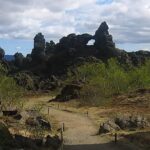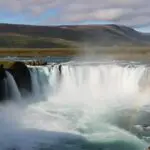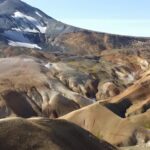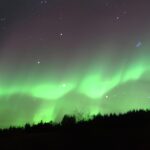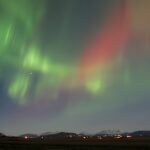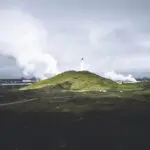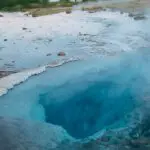Iceland and Greenland are closely linked historically, tracing back to the Viking Age. During this time, Norse settlers, including notable figures such as Eirik the Red and his son Leif Erikson, established the initial settlements in Greenland following their colonisation of Iceland. Moreover, Greenland’s history is significantly influenced by the island’s indigenous Inuit people, who have resided there for millennia.
The Inuit, the indigenous people of Greenland, possess a rich cultural heritage and have demonstrated remarkable resilience in adapting to the demanding Arctic environment. Their presence predates that of the Norse by several millennia, and their customs and lifestyle have significantly shaped Greenlandic culture. At present, the majority of Greenland’s populace is of Inuit descent, and their language, Kalaallisut, holds the status of being one of Greenland’s official languages.

In recent years, Iceland and Greenland have experienced a significant deepening of political and economic ties. This is evidenced by Iceland’s establishment of an embassy in Nuuk in 2013 and Greenland’s reciprocal action in Reykjavik in 2018. These diplomatic initiatives underscore the escalating level of cooperation between the two nations.
Iceland and Greenland collaborate across various sectors, including fisheries, aviation, air traffic control, tourism, and Arctic affairs.
Eirik the Red: The Saga of Greenland’s Nordic Settler
Eirik the Red, a name synonymous with adventure and exploration, played a pivotal role in the history of Iceland and Greenland. If you are interested in the Icelandic Sagas, check out our blog on The Icelandic Sagas for Beginners.
Early Life and Exile
Born in Norway around 950 AD, Eirik Thorvaldsson earned his moniker “Eirik the Red” due to his fiery hair and fierce temperament. His family moved to Iceland when he was still young after his father was exiled for manslaughter. Eirik inherited his father’s propensity for conflict, leading to his exile from Iceland around 982 AD after a series of violent disputes.
Discovering Greenland
Banished from Iceland, Eirik set sail westward in search of new lands. After a treacherous journey, he and his crew landed on the rugged, icy coast of a seemingly vast, uncharted island. Eirik named this new land “Greenland,” a somewhat optimistic marketing ploy intended to attract settlers by making the land sound more inviting than its icy reality.
Settling Greenland

Eirik spent three years exploring the coasts of Greenland, mapping its fjords and valleys. In 985 AD, he returned to Iceland, gathering a group of adventurous settlers willing to follow him to this new land. His persuasive vision worked, and in 986 AD, Eirik led a fleet of 25 ships back to Greenland. Despite losing several boats during the perilous voyage, the survivors established the first Norse settlements in Greenland. Eirik founded the Eastern Settlement near present-day Qaqortoq and the Western Settlement further north.
Legacy
Eirik the Red’sRed’s settlement of Greenland marked the beginning of Norse expansion into the North Atlantic. His ventures paved the way for future explorations, including those of his son, Leif Erikson, who would famously become one of the first Europeans to set foot in North America.
Leif the Lucky: The Viking Who “Discovered” America

Leif Erikson, known as “Leif the Lucky,” is famed as the first European to set foot in North America. Born around 970 AD in Iceland, he was the son of Eirik the Red, the founder of Greenland’s first Norse settlements.
The Journey to Vinland
Around 1000 AD, Leif set sail westward from Greenland, inspired by tales of distant lands. He and his crew landed on what is now believed to be Newfoundland, Canada, and named the land “Vinland” due to its abundant wild grapes.
Exploration and Return
Leif and his crew spent the winter exploring Vinland, noting its rich resources and milder climate than Greenland. They built shelters, gathered supplies, and then returned to Greenland with stories of this new land.
Legacy
Leif’s discoveries prompted further Norse expeditions to Vinland, though no permanent settlements were established. Celebrated as the first European to reach North America, nearly 500 years before Columbus, Leif Erikson is honoured in the United States with Leif Erikson Day on 9 October, recognising his contributions to exploration.
The Herjolfsnes Dress

The Herjolfsnes dress, a significant archaeological find from medieval Greenland, was discovered during excavations in 1921 and 1922 at the Herjolfsnes settlement. Danish archaeologist Poul Nørlund led the team that unearthed these well-preserved woollen garments from Norse graves dating from the 14th to the 15th centuries, providing valuable insights into the clothing and daily life of Norse settlers.
Featuring a simple yet practical design, the dresses have fitted bodices, long sleeves, and flared skirts, allowing for ease of movement. The typical fastening methods include laces or buttons, indicating a level of sophistication in their construction. Some dresses include decorative embroidery around the neckline, cuffs, and hem, showing that these garments were both functional and aesthetically pleasing. Several variations of the Herjolfsnes dress reflect different styles and purposes, from everyday wear to special occasions.
The Herjolfsnes dress exemplifies how Norse settlers adapted European clothing styles to the challenging Arctic environment, showcasing their resourcefulness. These garments provide a rare opportunity to study medieval textile techniques and fashion. They offer a unique window into the lives of Norse Greenlanders. If you are interested in reconstructing medieval garments, there’s a book with patterns made from the dresses.
Preserved at the National Museum of Denmark, the Herjolfsnes garments continue to be examined and admired, offering invaluable insights into the cultural and material history of the Norse in Greenland.
Greenland’s Path to Becoming a Danish Colony and Its Current Status
Colonial History
Greenland’s association with Denmark as a colonial territory commenced in the early 18th century. Despite the prior Norse settlements during the Viking Age, which eventually faded into obscurity, Europe’s attention towards Greenland waned for many centuries. Meanwhile, the indigenous Inuit populace sustained their livelihoods through their profound understanding of the Arctic environment.
In 1721, Hans Egede, a Danish-Norwegian missionary, embarked on a mission to Greenland to reinstate a Christian presence and explore potential trade prospects. This event heralded the inception of Danish influence in Greenland. Subsequently, Denmark solidified its authority over Greenland, officially recognising Greenland as a Danish colony in 1814 under the Treaty of Kiel.
Move Toward Home Rule

Greenland remained a Danish colony until the mid-20th century. After World War II, its governance underwent a significant shift. In 1953, Denmark integrated Greenland into its kingdom, ending its colonial status and establishing it as an integral part of Denmark. This transition aimed to modernise Greenland’s economy and infrastructure. However, demands for increased autonomy persisted. In 1979, Denmark granted Greenland home rule, resulting in greater self-governance. The Home Rule Act delegated numerous responsibilities from the Danish government to the Greenlandic government, including oversight of local resources, education, and healthcare services.
Move Toward Self-Governance
Greenland voted favourably for the Self-Government Act in 2008, enacted in 2009. This act led to a significant expansion of Greenland’s autonomy. Under the provisions of the Self-Government Act, Greenland assumed control over its police force, judicial system, and natural resources. The official language transitioned to Greenlandic (Kalaallisut), and the Greenlandic government acquired heightened authority in foreign affairs. Nonetheless, defence and foreign policy matters continue to fall within Danish jurisdiction.
Vestnorden: Strengthening North Atlantic Tourism
Vestnorden is an annual travel trade show that brings together Iceland, Greenland, and the Faroe Islands to promote tourism and regional cooperation.
Travel agencies and tour operators showcase their services at the event, building business connections. Workshops and seminars cover sustainable travel, marketing, and new tourist attractions. The event also encourages cultural exchange, allowing participants to learn about each other’s heritage and traditions.
Vestnorden helps boost tourism in Iceland, Greenland, and the Faroe Islands by increasing their visibility and attracting visitors. It also promotes sustainable tourism practices to protect these regions’ natural beauty and cultural heritage.
Travelling from Iceland to Greenland

Travelling from Iceland to Greenland is straightforward, mainly through direct flights. Air Greenland operates direct flights from Reykjavik’s Keflavik International Airport to Nuuk, Ilulissat, and Kangerlussuaq, with flight times around 3-4 hours. These routes are prevalent in the summer. Icelandair also operates direct flights to Nuuk, Kulusuk, Ilulissat and Narsarsuaq.
Travel agencies often offer package tours that include flights, accommodations, and guided excursions. That makes exploring activities like hiking, whale watching, and visiting glaciers easy.
It’s best to book flights and accommodations in advance, especially during peak season. Check visa requirements, as Greenland’s policies may differ from Iceland’s. Pack warm clothing and gear suitable for Greenland’s cold and unpredictable weather.

